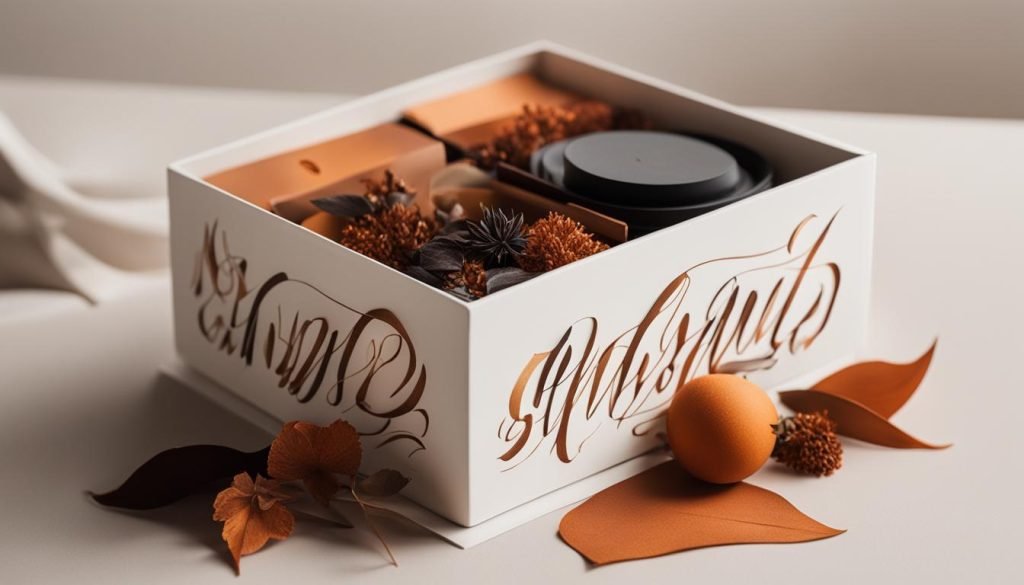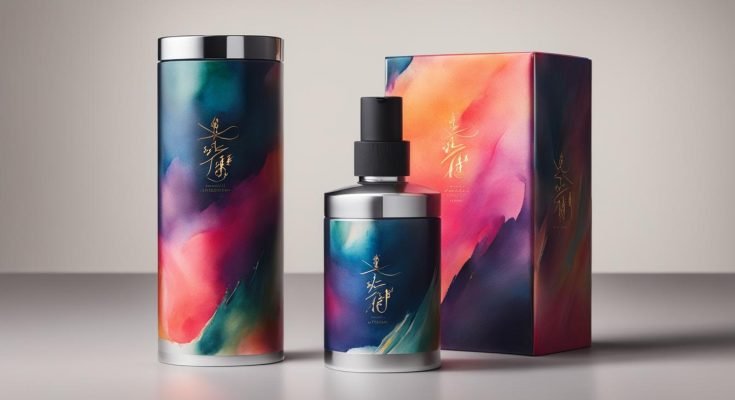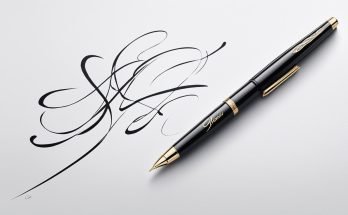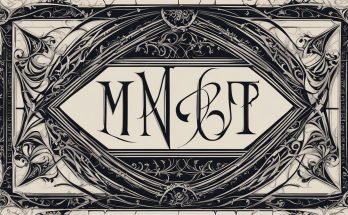Chinese calligraphy is an independent art form that uses writing brushes to create Chinese characters. It has been developed continuously throughout history and has high aesthetic value. Calligraphy has the rhythm of music and the charm of dance, making it a unique art form. In modern design, Chinese calligraphy is being incorporated into visual communication and packaging design, merging traditional artistry with modern design concepts.
The use of calligraphy in product packaging can elevate a brand’s aesthetic and create a strong visual impact on consumers. Japanese designers have already embraced calligraphy in packaging design, creating a unique style that attracts consumers’ attention and promotes sales. The use of calligraphy in packaging design can reflect the characteristics of the product and its cultural connotations, creating a sense of elegance and sophistication. The proper use of calligraphy in packaging design can enhance the overall branding and create a memorable impression on consumers.
Calligraphy in product packaging presents endless opportunities for brands to enhance their aesthetic appeal and create a strong brand identity. By incorporating calligraphy into packaging design, brands can elevate their products and stand out in the competitive market.
Key Takeaways:
- Chinese calligraphy is an independent art form that merges traditional artistry with modern design concepts.
- The use of calligraphy in product packaging elevates a brand’s aesthetic and creates a strong visual impact on consumers.
- Japanese designers have successfully incorporated calligraphy in packaging design to attract consumers’ attention and promote sales.
- Calligraphy in packaging design reflects the characteristics of the product and its cultural connotations, creating elegance and sophistication.
- Incorporating calligraphy into packaging design enhances overall branding and creates a memorable impression on consumers.
The Role of Calligraphy in Packaging Design
Calligraphy plays a crucial role in packaging design, adding an artistic and aesthetic element to the overall presentation of a product. By incorporating calligraphy into packaging, brands can create unique and personalized designs that set their products apart from competitors. Handwritten calligraphy, with its authentic and organic feel, can add a touch of craftsmanship and individuality to packaging.
Modern calligraphy styles offer versatility, allowing designers to adapt them to suit various product categories. From delicate and flowing scripts to bold and expressive lettering, calligraphy can convey different brand personalities and messages. Handcrafted calligraphy artwork on packaging acts as a visual storytelling tool, capturing consumers’ attention and creating a memorable impression.
One area where calligraphy excels in packaging design is logo creation. Incorporating calligraphy into the logo design can result in a distinctive and memorable brand identity. The unique letterforms and intricate strokes of calligraphy make for a visually striking logo that stands out in consumers’ minds.
Furthermore, calligraphy-inspired product packaging adds an element of elegance and sophistication. By integrating calligraphy into the overall design, brands can create a cohesive and visually appealing packaging experience. The attention to detail and artistic touch of calligraphy can elevate the perceived value of a product and enhance its appeal to consumers.
Calligraphy in packaging design adds a sense of craftsmanship and attention to detail, contributing to a positive brand image.
Whether used as an artwork on the packaging or incorporated into typography and graphics, calligraphy breathes life into product packaging. It reflects a brand’s dedication to quality and aesthetics, fostering a deeper connection with consumers. The unique blend of tradition and modernity found in calligraphy enriches packaging design, creating a visual language that resonates with consumers on an emotional level.
The Impact of Calligraphy on Consumer Perception

Incorporating calligraphy into product packaging design can have a profound influence on consumer perception and brand recognition. By utilizing calligraphy, brands can convey a sense of tradition, elegance, and authenticity that resonates with consumers, leaving a lasting impression.
Calligraphy packaging trends have been on the rise as companies look for innovative ways to differentiate their products and create a unique brand identity. By embracing calligraphy as a form of product branding, companies can tap into the power of this age-old art form and connect with consumers on a deeper level.
Elevating Brand Image
Calligraphy adds a touch of craftsmanship and attention to detail to product packaging, enhancing the perceived value of the brand. It conveys a sense of care and dedication, signaling to consumers that the brand takes pride in its products and delivers excellence.
“The use of calligraphy in packaging design allows brands to create a memorable visual experience for consumers, evoking emotions and enhancing the overall brand perception.” – John Chen, Branding Expert
Creating a Sense of Authenticity
By integrating calligraphy into packaging design, brands can evoke a sense of authenticity that captivates consumers. Calligraphy has a rich cultural heritage and carries the weight of tradition, adding depth and meaning to the brand’s message.
Aesthetic Appeal and Attention to Detail
Calligraphy brings an unmatched aesthetic appeal to product packaging, capturing the attention of consumers. With its fluidity and elegance, calligraphy can transform ordinary packaging into a work of art, creating a strong visual impact.
| Benefits of Calligraphy in Packaging Design | Consumer Impact |
|---|---|
| Conveys tradition, elegance, and authenticity | Influences brand perception and recognition |
| Elevates the perceived value of the product | Creates a sense of craftsmanship and attention to detail |
| Evokes a sense of authenticity and cultural heritage | Connects with consumers on a deeper level |
| Enhances aesthetic appeal and visual impact | Captivates consumer attention |
The impact of calligraphy on consumer perception is undeniable. As calligraphy packaging trends continue to evolve, brands have the opportunity to leverage this powerful art form to create a memorable brand experience and foster a strong connection with their target audience.
The Versatility of Calligraphy in Packaging Design
Calligraphy offers a wide range of possibilities in packaging design. It can be used to convey brand messages, product information, or simply as a decorative element. Calligraphy on packaging creates a visual impact and attracts attention, making the product stand out on store shelves.
With calligraphy, designers have the freedom to experiment with various font styles, sizes, and colors, allowing them to tailor the design to different product categories and brand aesthetics. Whether it’s a bold and dramatic calligraphy font for a luxury perfume or a delicate and flowing script for a handcrafted soap, calligraphy adds a touch of elegance and sophistication to the packaging.
Additionally, calligraphy can be seamlessly incorporated into packaging graphics, patterns, or illustrations, further enhancing the artistic appeal of the design. By integrating calligraphy elements, brands can infuse their packaging with a sense of craftsmanship and attention to detail, creating a unique and memorable visual experience for consumers.
Examples of Calligraphy in Packaging Design
Let’s take a look at some examples of calligraphy in packaging design:
“The Soap Co.” uses elegant calligraphy for their product names, enhancing their luxurious and handmade branding. The intricate brush strokes communicate the brand’s commitment to quality and craftsmanship.
“GreenLeaf Tea” incorporates calligraphy-inspired patterns on their tea packaging, evoking a sense of tradition and tranquility. The intricately designed calligraphy motifs create a harmonious and visually appealing packaging.
| Product | Brand | Calligraphy Elements |
|---|---|---|
| Perfume | Aura | Elegant calligraphy font for the brand name and product description |
| Handmade Soap | Artisan Goods | Delicate calligraphy script for the product name and ingredients |
| Tea | Harmony Brew | Calligraphy-inspired patterns and motifs on the packaging |
These examples illustrate the versatility of calligraphy in packaging design, showcasing how it can be used to create unique and customized packaging that aligns with the brand’s identity and captures the essence of the product.
In the next section, we will explore the impact of calligraphy on consumer perception and delve deeper into the growing calligraphy packaging trends.
Conclusion
Calligraphy in product packaging provides a unique opportunity for brands to enhance their aesthetic appeal and establish a strong brand identity. By incorporating calligraphy into packaging design, brands can elevate their products and differentiate themselves in the competitive market.
Calligraphy offers versatility, allowing designers to create personalized and captivating packaging that resonates with consumers. From logo designs to artwork and typography, calligraphy adds a touch of elegance and authenticity to packaging, creating a lasting impression on customers.
As calligraphy packaging trends continue to evolve, brands can explore innovative ways to incorporate calligraphy into their packaging strategies. This timeless art form not only reflects the cultural richness and heritage but also offers a modern marketing potential that captivates consumers.
With calligraphy in product packaging, brands can create a memorable brand experience that reflects their values and captivates consumers’ attention. Embracing calligraphy in packaging design allows brands to stand out, project elegance, and elevate their products, a valuable tool for branding with beauty.
FAQ
What is calligraphy and how is it used in product packaging?
Calligraphy is an independent art form that uses writing brushes to create Chinese characters. It is being incorporated into modern design, including product packaging, to merge traditional artistry with modern concepts.
How can calligraphy enhance the overall branding of a product?
Calligraphy adds an artistic and aesthetic element to the packaging design, creating a strong visual impact on consumers and reflecting the characteristics and cultural connotations of the product.
What role does calligraphy play in logo design for packaging?
Calligraphy can be used to create a distinctive and memorable brand identity, adding a touch of elegance and sophistication to the overall packaging design.
How does calligraphy in packaging design impact consumer perception?
Calligraphy conveys a sense of tradition, elegance, and authenticity, resonating with consumers and creating a positive brand image. It also enhances the perceived value of a product through its craftsmanship and attention to detail.
How versatile is calligraphy in packaging design?
Calligraphy can be used to convey brand messages, product information, or simply as a decorative element. It can be customized to suit different product categories and brand aesthetics, creating unique and personalized packaging.




